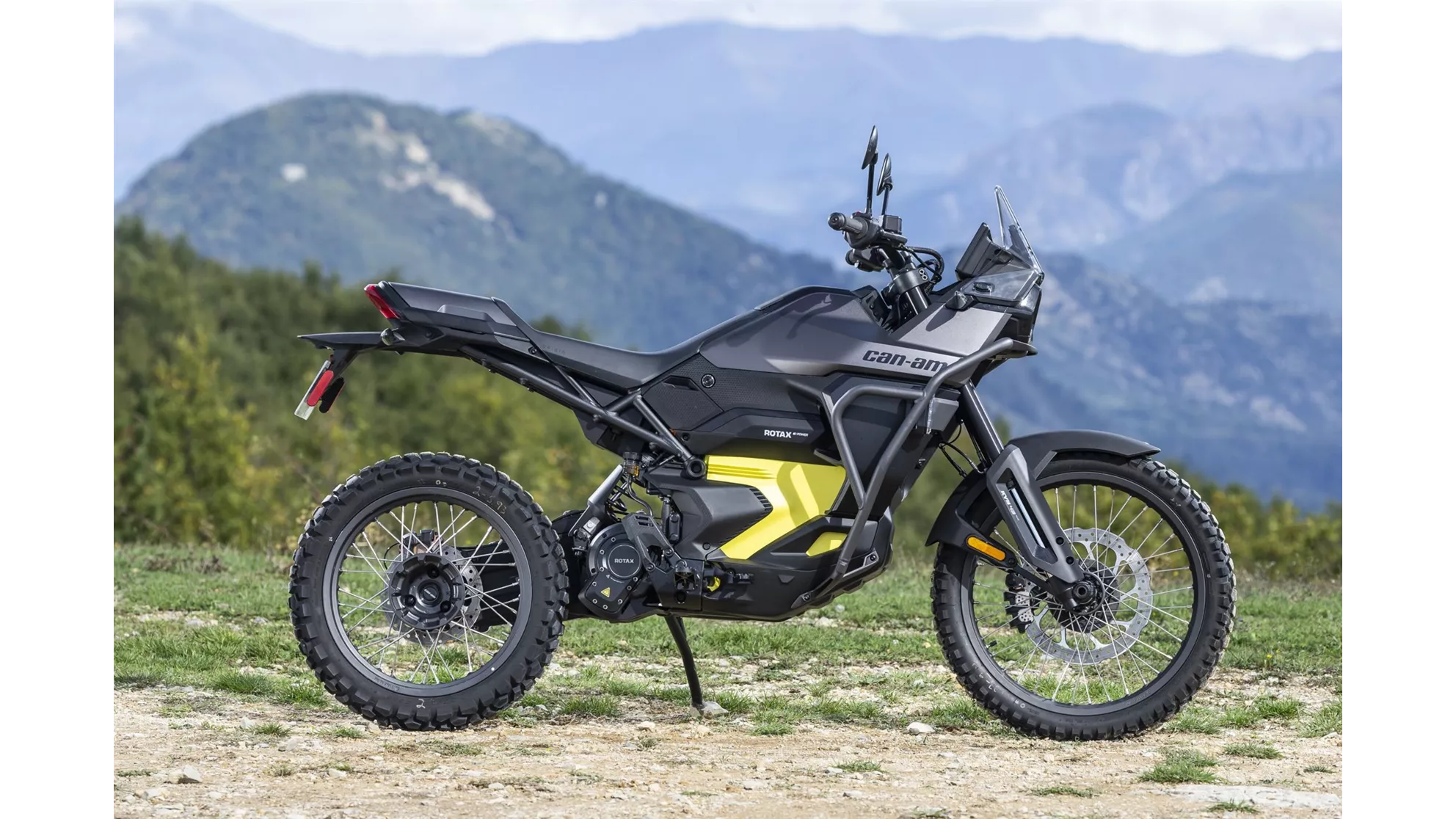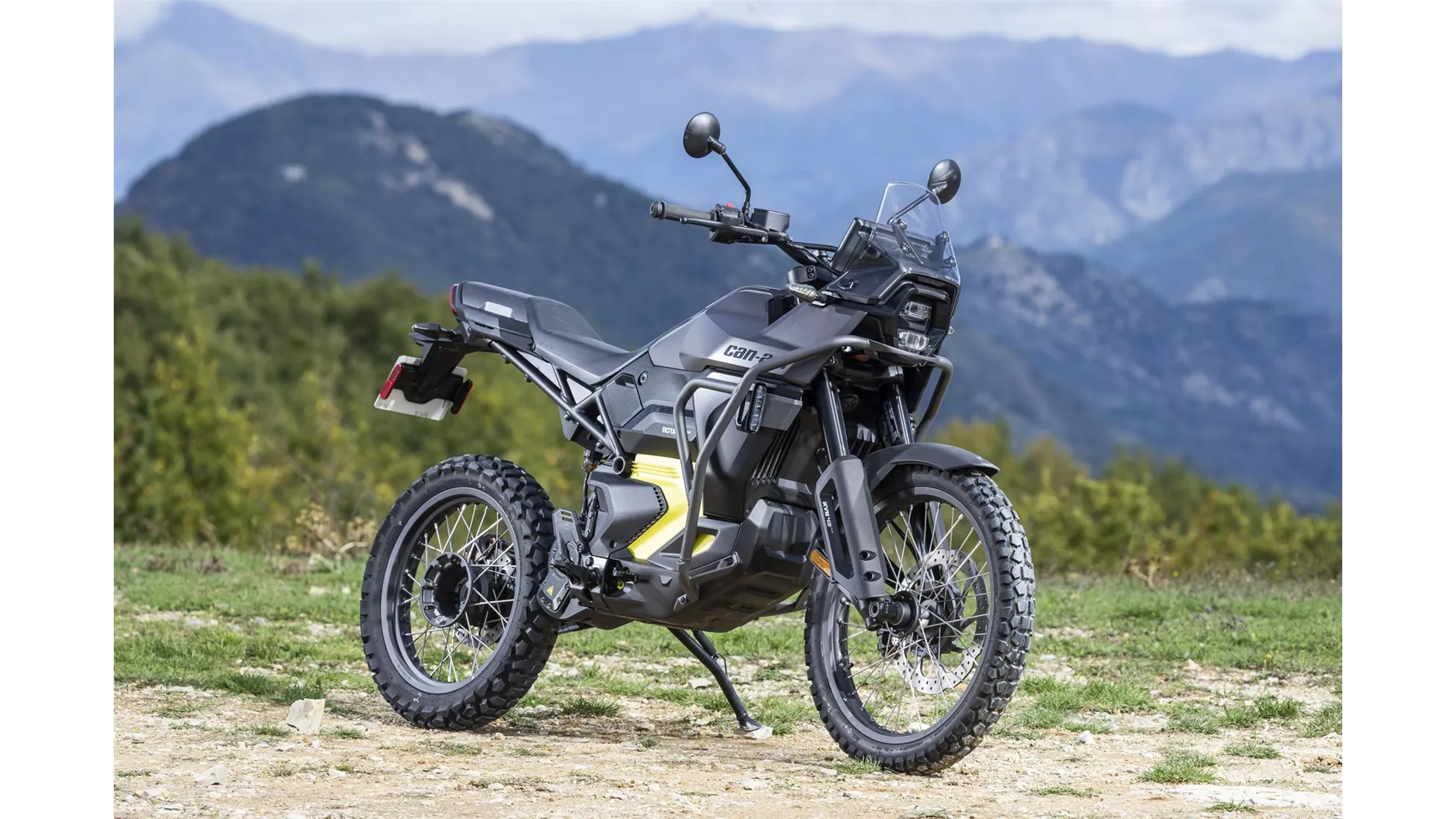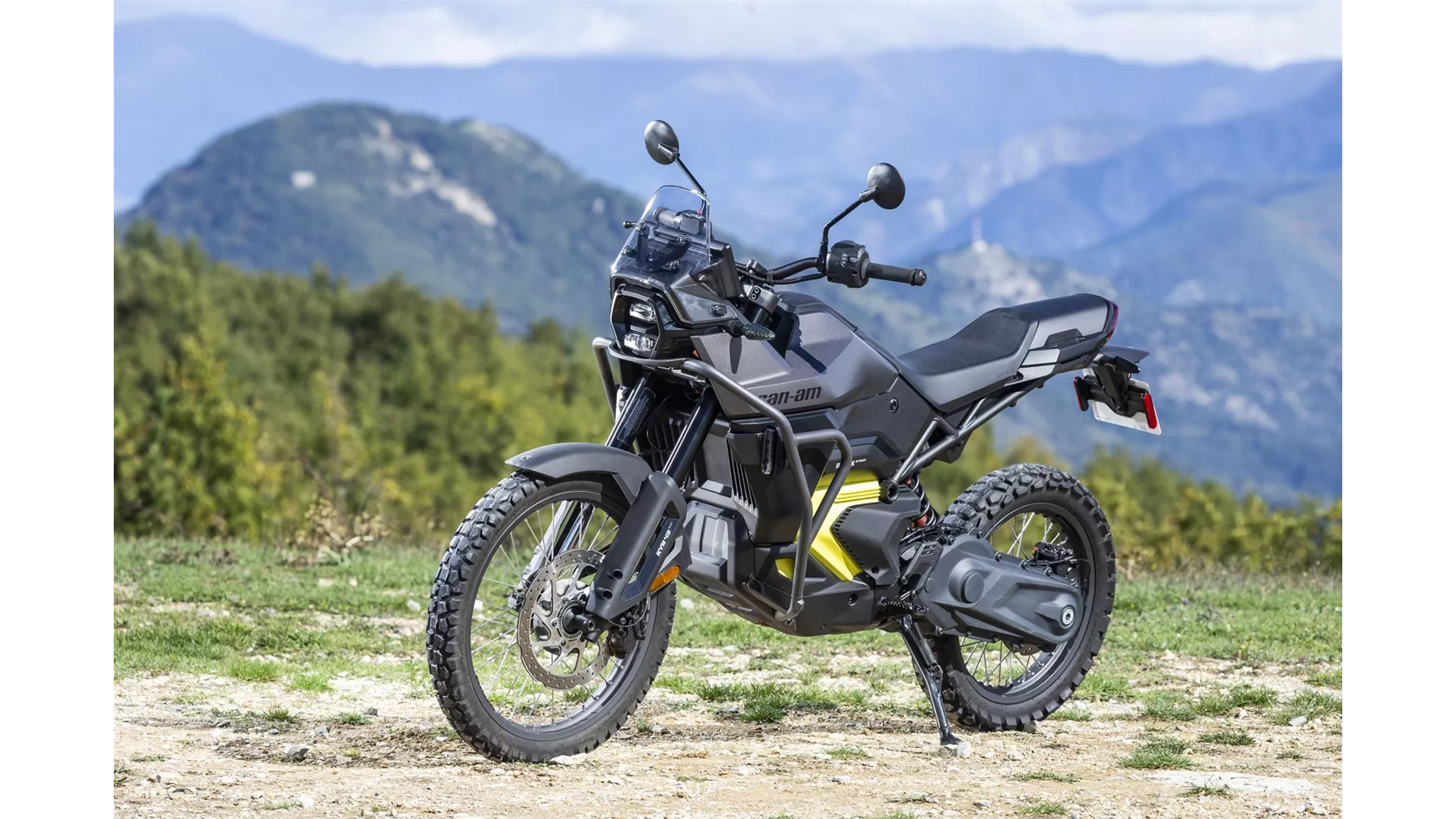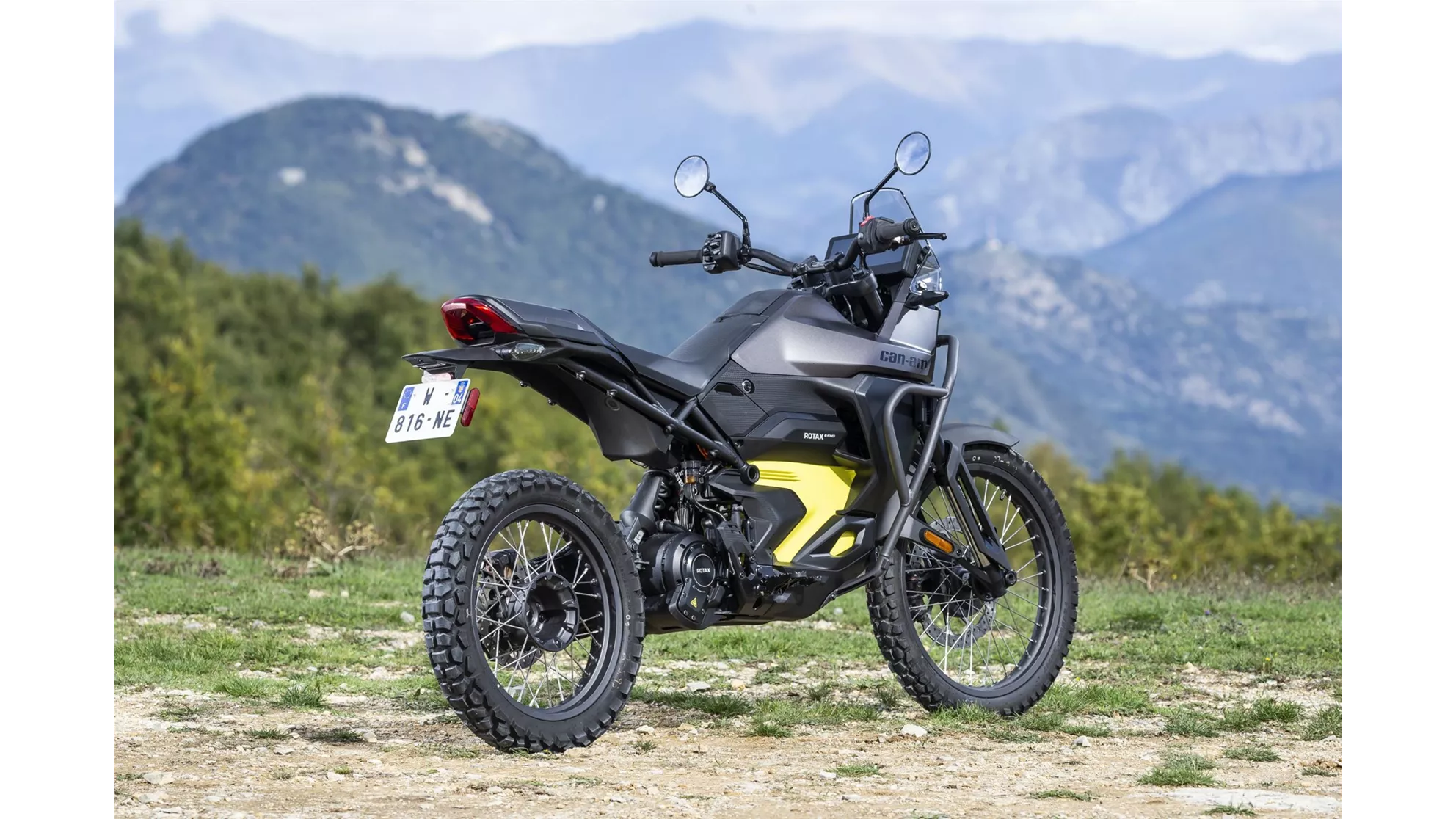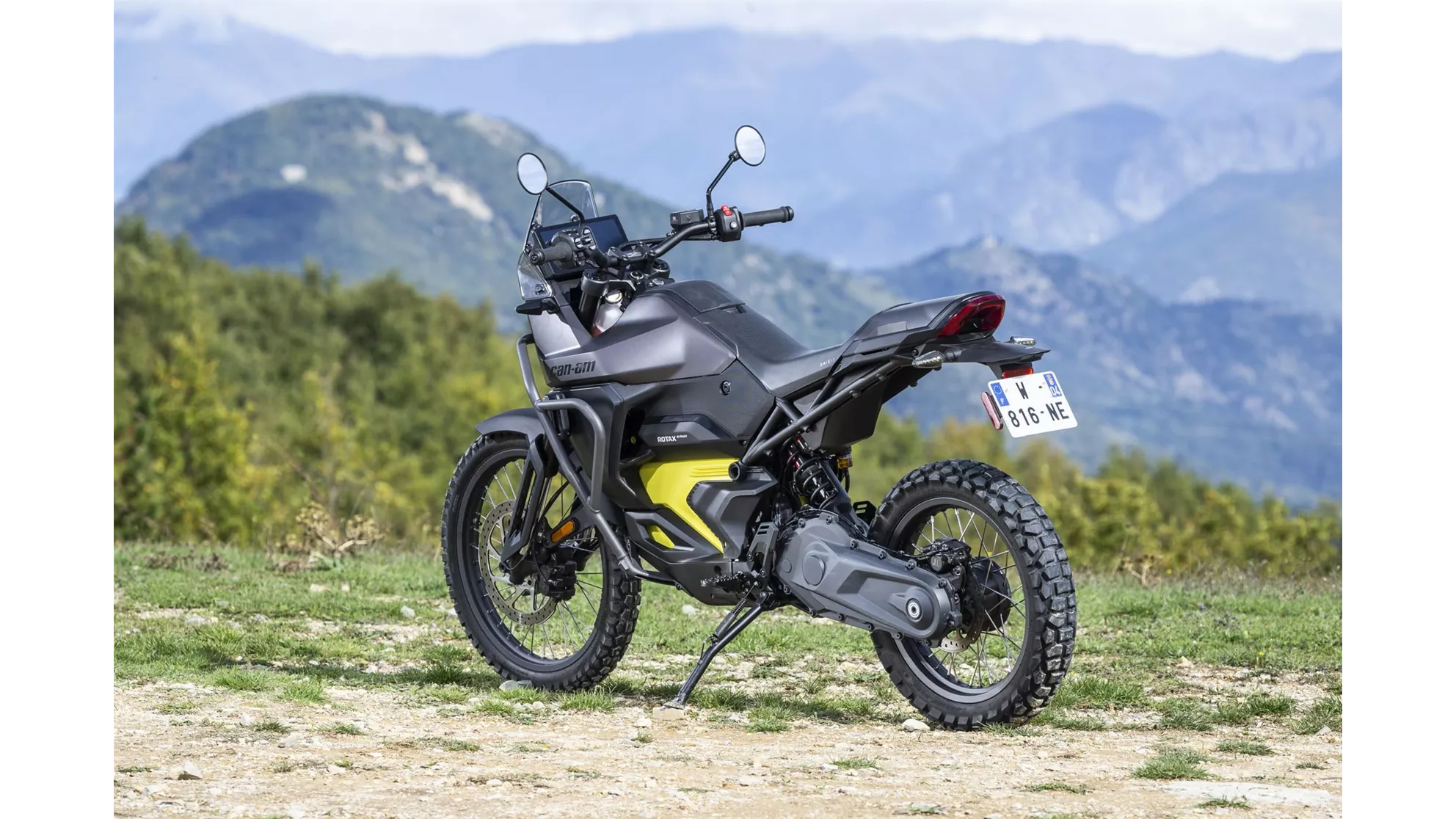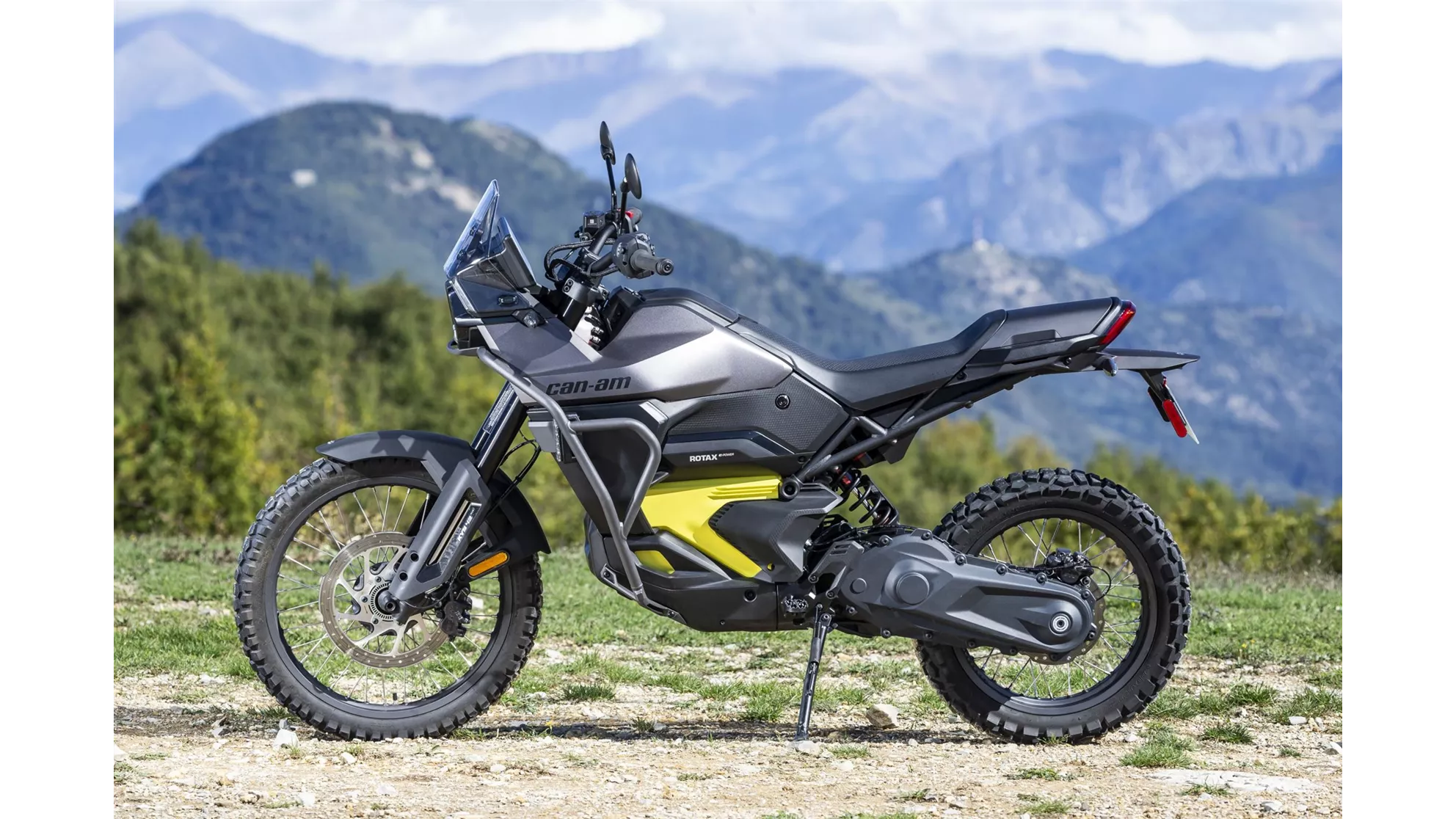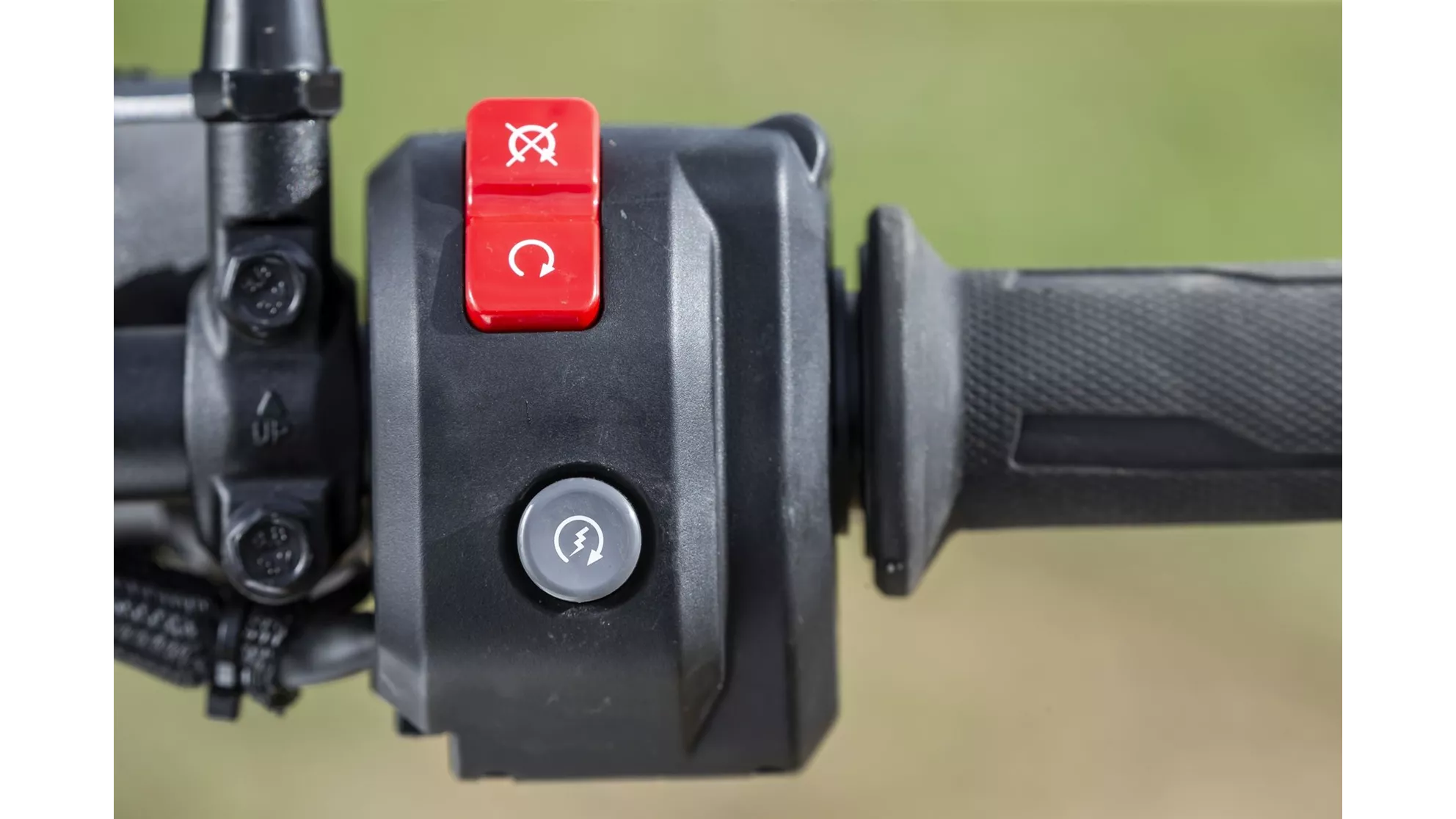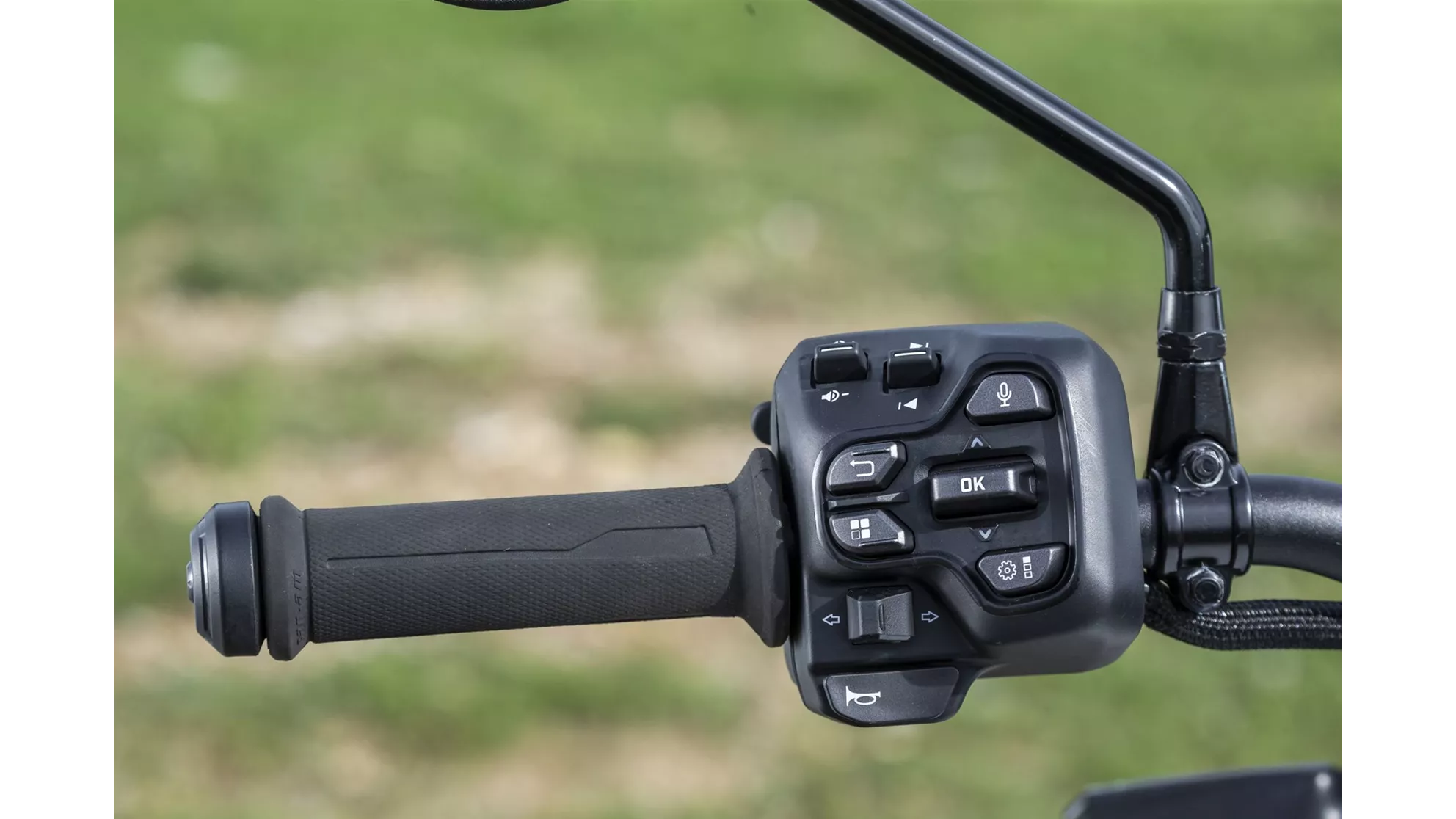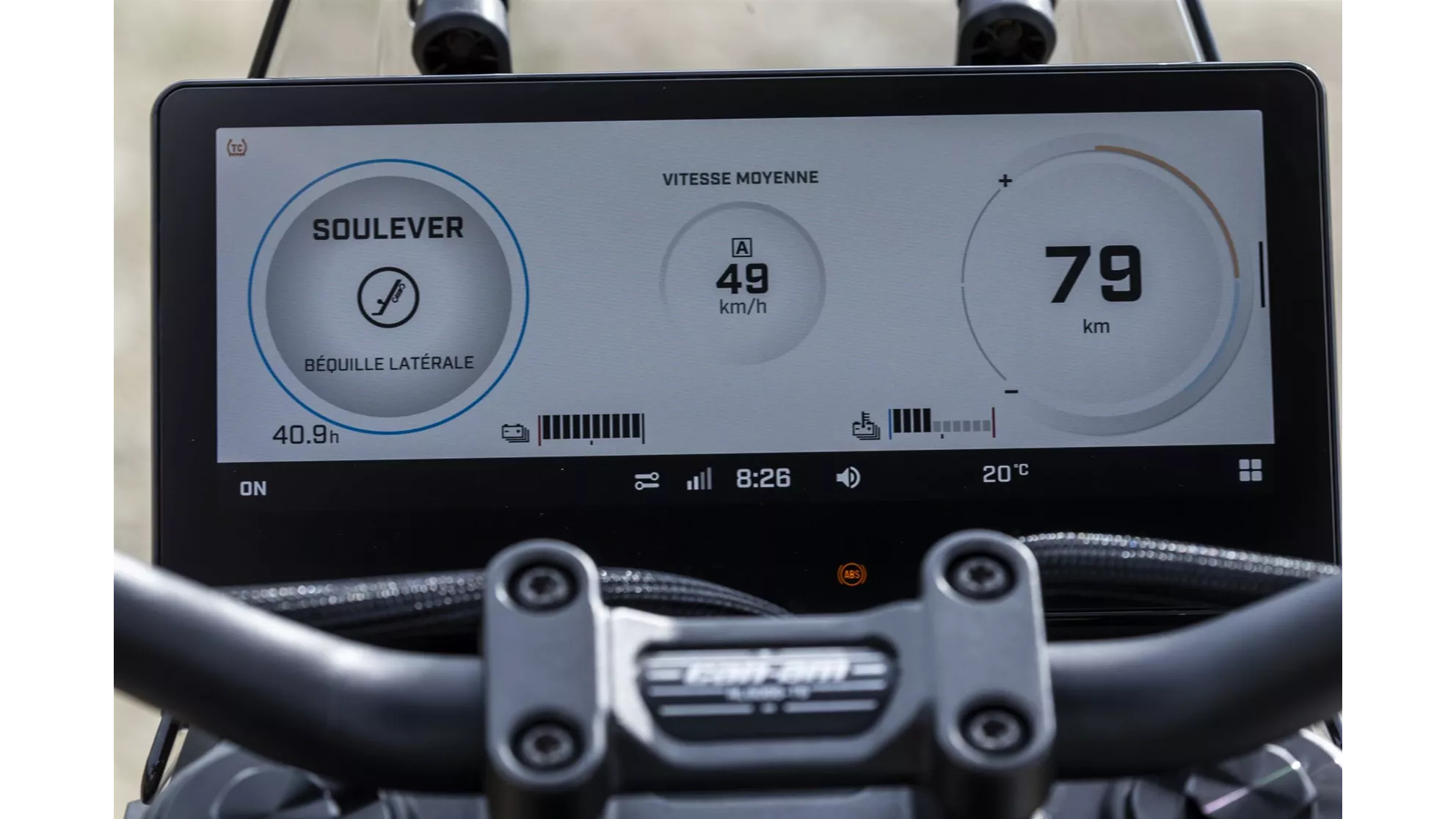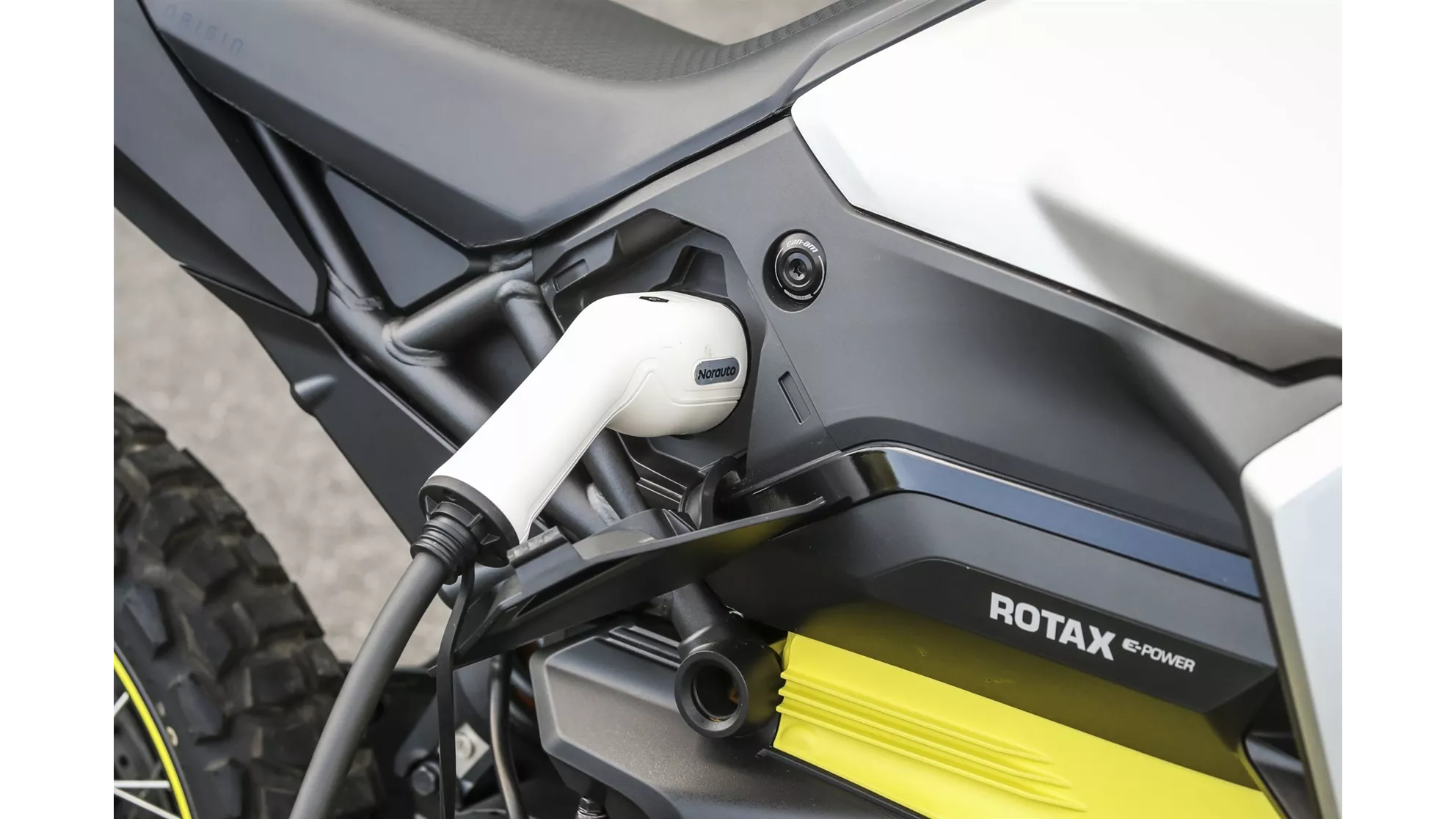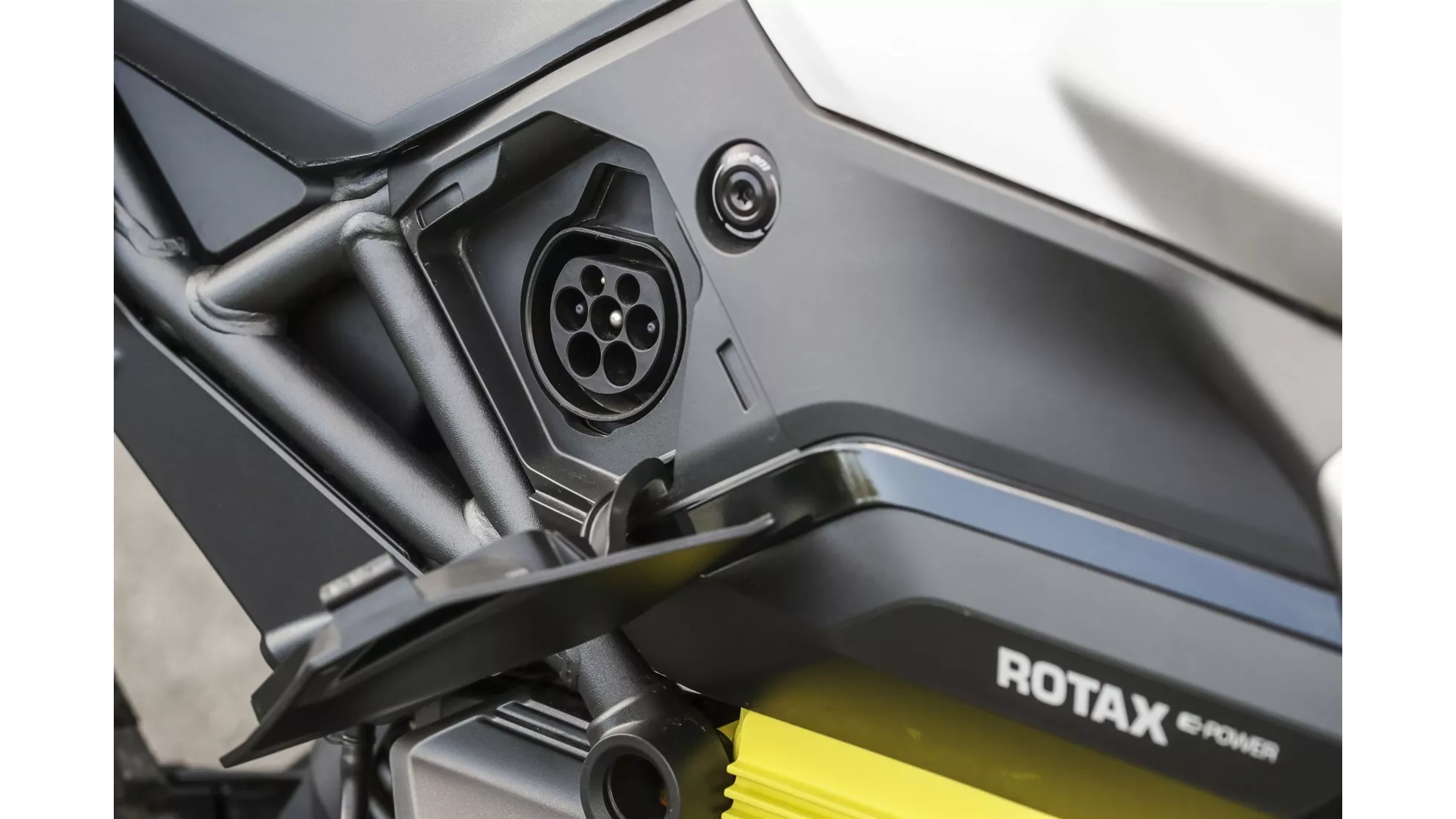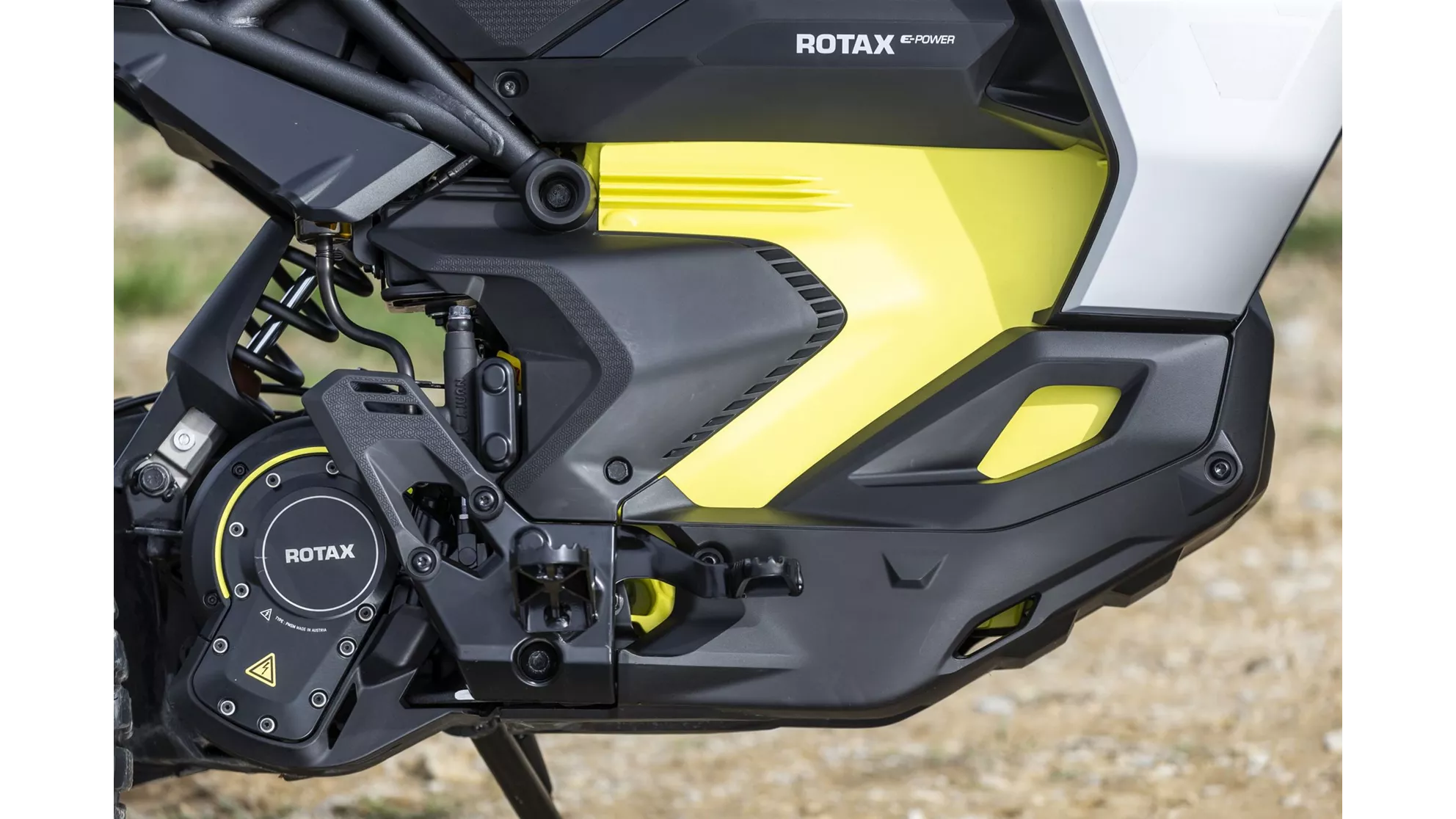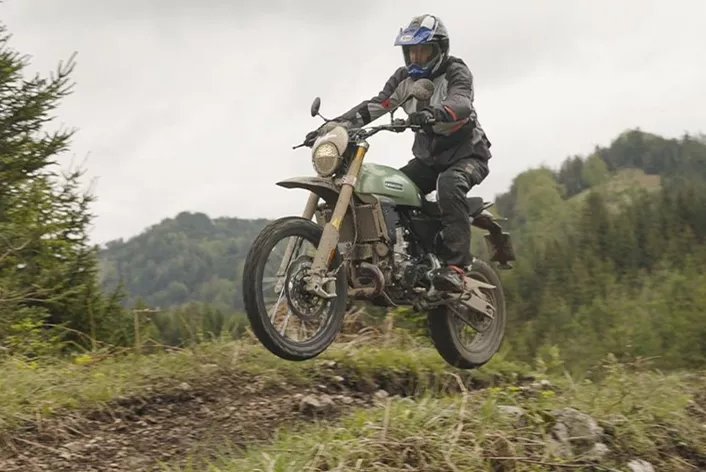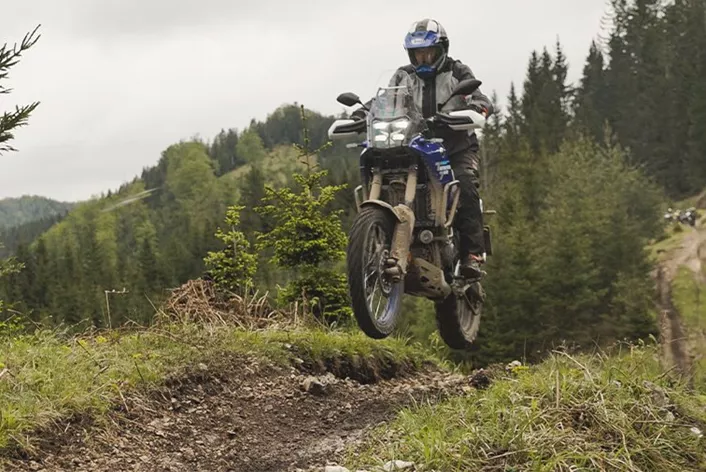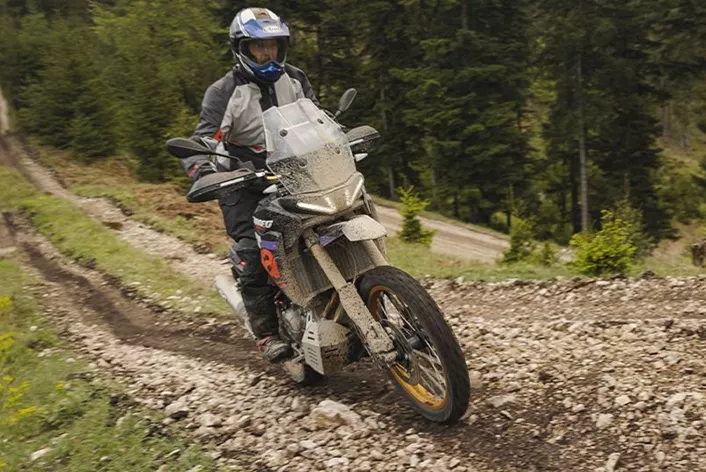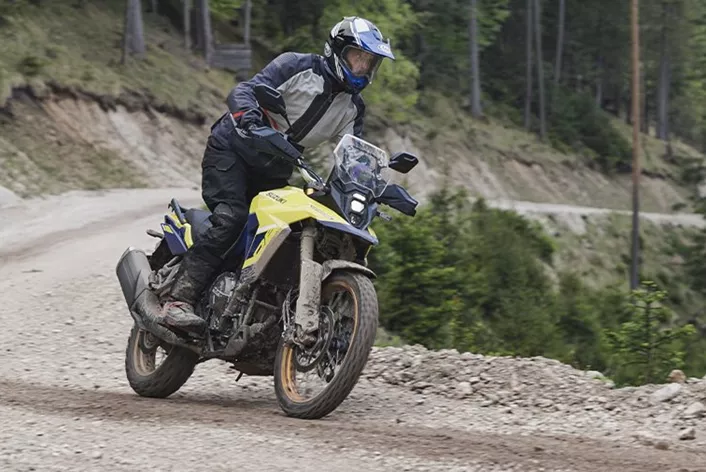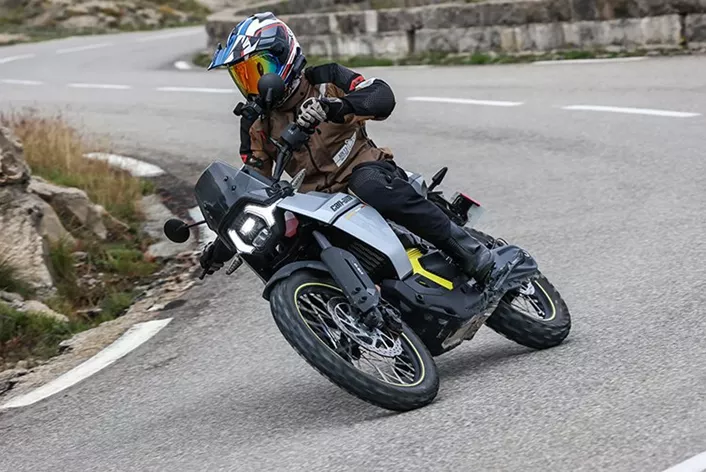At the 2025 Off-Road Test Days, six motorcycles face challenging conditions at the Red Stag Enduro Park in Rohr im Gebirge. Among them is the Can-Am Origin 2025, an electric adventure bike designed to excel in off-road conditions. I gathered initial impressions at its launch in France, but the terrain there was rather mild - just a few gravel meters. Now, it's serious business: the dense forest, deep mud, and challenging inclines around Red Stag Park test the limits of every off-road bike. The tests are conducted from various perspectives - with Mex as an ambitious hobby rider, Busty Wolter as a seasoned enduro pro, and adventure rider McGregor. This provides a comprehensive view of how the e-bike performs for both beginners and advanced riders alike.
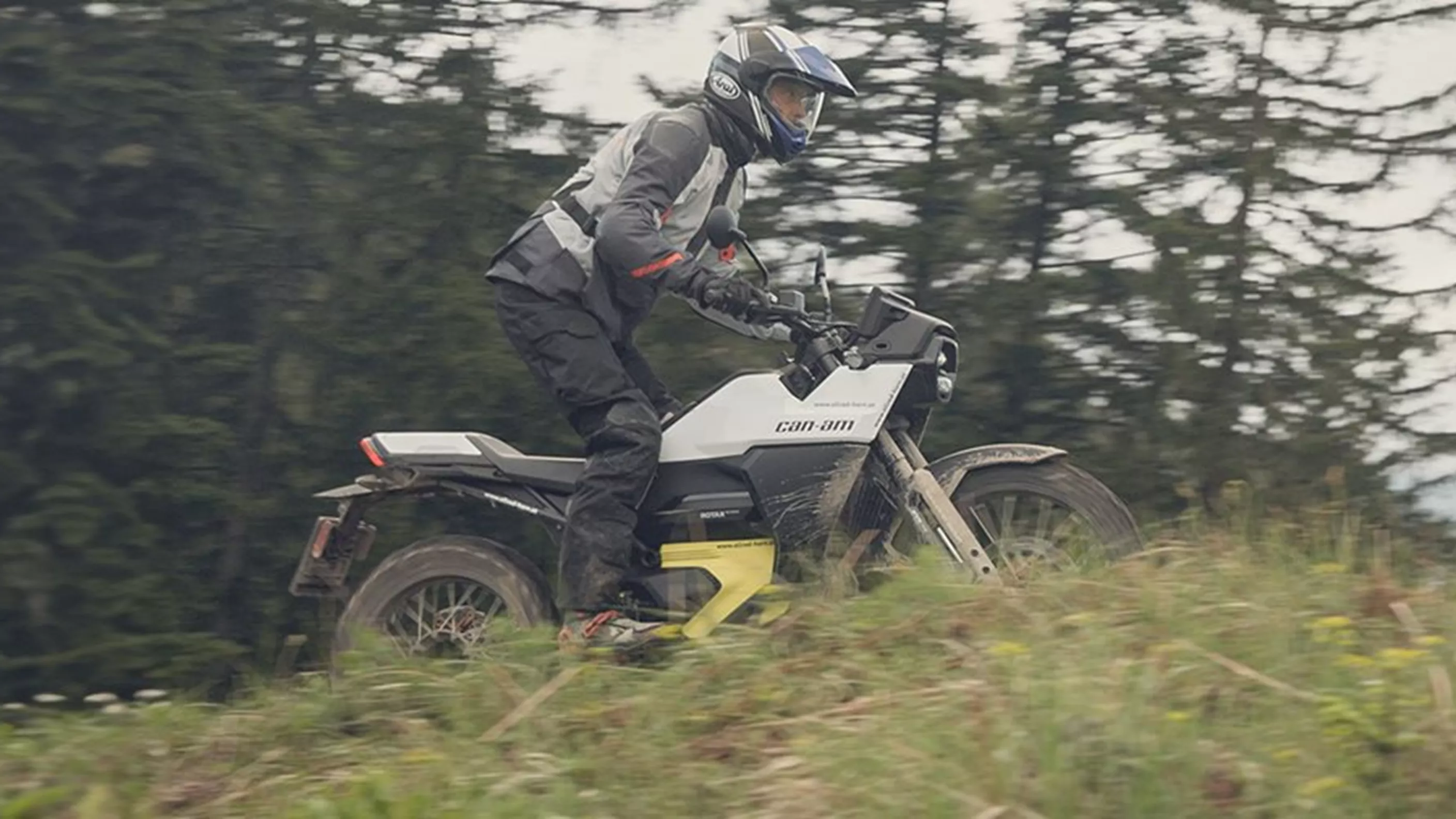
Can-Am Origin 2025 Off-Road Test
Electric Enduro in the Rough - How It Really Performs!
Now it's getting serious: The Can-Am Origin 2025 faces the ultimate challenge at the Off-Road Test Days in Red Stag Park, proving itself in real terrain - with both amateur and pro riders!
&width=72&height=72&bgcolor=rgba_39_42_44_0&mode=crop)
Gregor
published on 03/07/2025
Red Stag Enduro Park – The Perfect Stage for Authentic Off-Road Adventures
Nestled in the forest under a dense canopy, the Red Stag Enduro Park is an off-road playground like no other. This terrain offers everything an enduro rider could dream of: gravel, deep forest floor, winding trails, narrow passages, and even technically demanding climbs. Especially in mixed weather, it becomes evident how serious Yamaha and 1000PS are about rigorous testing. This is no sterile test area, but a place where bikes are tested under real-world conditions - with mud, rocks, roots, and everything a true enduro challenge entails. Those who succeed here truly earn the "adventure-ready" badge. For the test crew of Busty Wolter, Mex, and McGregor, it's the perfect spot to push the Can-Am Origin to its limits.
Powerful Electric Thrust - The Engine of the Can-Am Origin
For an electrically powered adventure bike, the Can-Am Origin 2025 offers a typically robust, torque-heavy performance characteristic. Particularly impressive is the immediate thrust of the electric motor, which pushes forward with noticeable force right from the start. Intriguingly, Can-Am, as a subsidiary of the Canadian BRP Group, is also a sister company to the Austrian engine manufacturer Rotax, which builds the electric motors for Can-Am. I was instantly impressed by the thrust, especially considering that we were testing the "mere" 11 kW version with about 15 hp, which is eligible for A1 license holders. Just in the first few meters, it practically sprints off, which offers a surprising punch for a bike in this licensing category.
Can-Am Origin 2025 - Key Facts
Engine and Drive Train
| Engine type | Electric |
|---|---|
| Engine power | 47 HP |
| Torque | 72 Nm |
| Cooling | liquid |
Suspension Front
| Front suspension | Upside-Down telescopic fork |
|---|---|
| Brand | Kayaba |
| Diameter | 43 mm |
| Travel | 255 mm |
Suspension Rear
| Suspension | Single swing arm |
|---|---|
| Shock absorber | Monoshock |
| Brand | Kayaba |
| Travel | 255 mm |
| Adjustment | Compression, Preload, Rebound |
Chassis
| Frame | Steel |
|---|---|
| Rake | 30 degree |
| Trail | 118 mm |
Brakes Front
| Type | Single disk |
|---|---|
| Diameter | 320 mm |
| Piston | Double piston |
Brakes Rear
| Type | Disc |
|---|---|
| Diameter | 240 mm |
| Piston | Single piston |
Assistance Systems
| Advanced Rider Assistance Systems | ABS, Riding modes, Ride by Wire, Traction control |
|---|
Dimensions and Weights
| Front tyre width | 90 mm |
|---|---|
| Front tyre height | 90 % |
| Front tyre diameter | 21 inch |
| Rear tyre width | 120 mm |
| Rear tyre height | 80 % |
| Rear tyre diameter | 18 inch |
| Length | 2204 mm |
| Width | 861 mm |
| Height | 1414 mm |
| Wheelbase | 1503 mm |
| Seat Height | 865 mm |
| Kerb Weight (with ABS) | 187 kg |
| Top Speed | 129 km/h |
| License compliancy | A2 |
| Range | 115 km |
| Charging plug | Typ 2 |
| Maximum charging power | 7 kW |
| Battery performance (kilowatt hours kWh) | 8.9 kWh |
| Payload | 338 kg |
| Maintenance interval | 10000 km |
| Ground clearance | 274 mm |
Equipment
| Equipment | Apple CarPlay, Bluetooth, Connectivity, LED-Headlights, TFT display, USB socket |
|---|
Of course, there is also a 35 kW version of the Origin with around 48 hp. When you keep the throttle open, it pulls significantly longer and stronger at the top end. But honestly, for off-road use—and unless your name is Busty Wolter and you're tearing through at killer speeds—the smaller variant is more than sufficient. There's plenty of thrust available. However, it's important to note: the drive concept is completely different from a combustion engine. We've all grown up with traditional engines, but this is another world—perhaps the future. It takes some getting used to at first, as the throttle control is purely electronic. Initial throttle movements should be cautious, as the massive torque comes on very directly. Those who disable traction control will quickly notice how the rear likes to step out.
What I particularly like about it: You ride much more with your ears. You can precisely hear when the rear starts to slip, when traction breaks. And then there are those earthy sounds - the crunching of stones, the squelching of the muddy forest floor. Consciously experiencing the nature around you is part of enduro riding. The quiet drive enhances this experience in an almost meditative way. Despite all the calm, there's no lack of power in any situation - at least for an amateur.
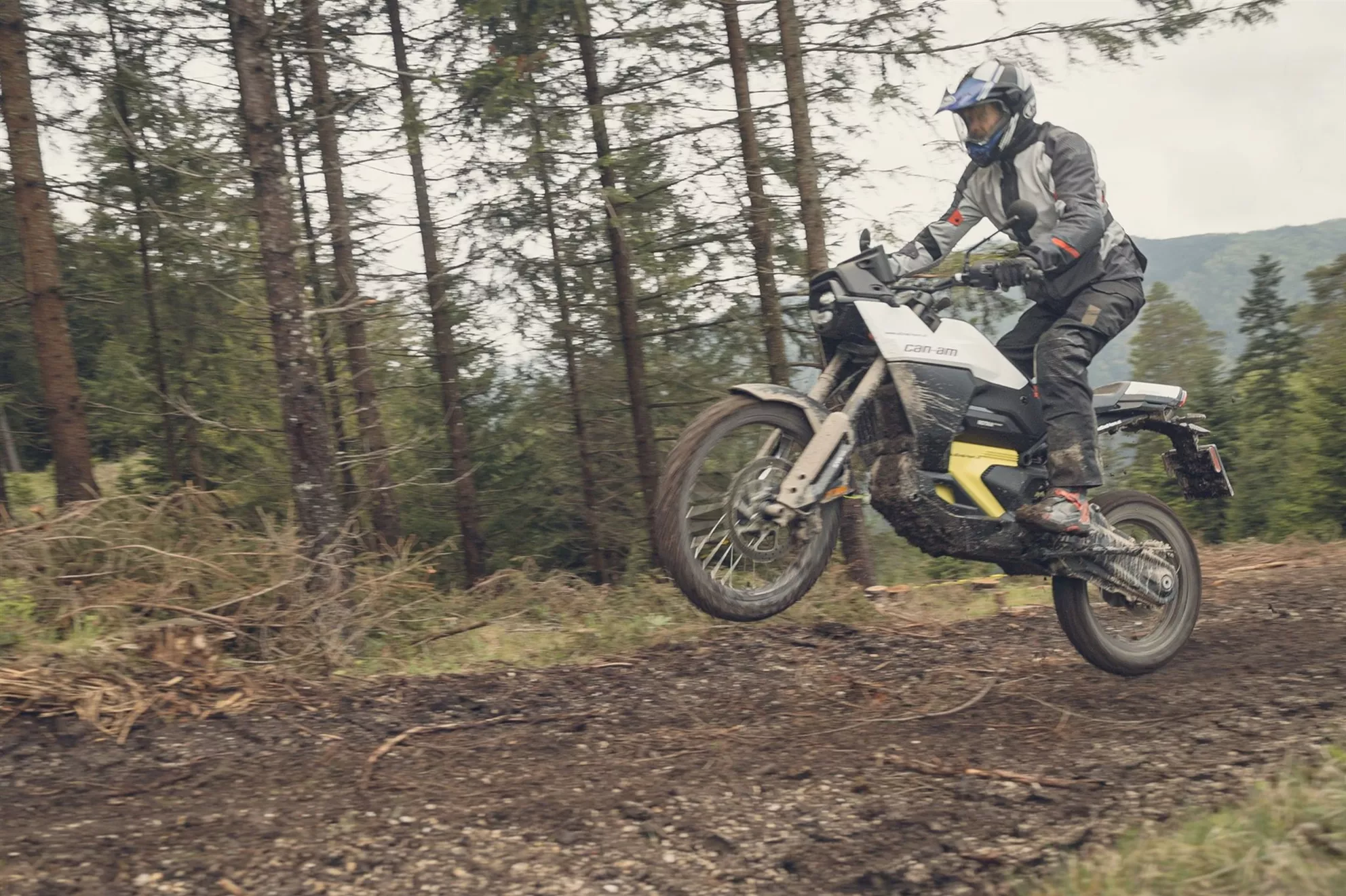
Juicy Torque - Even Busty enjoys the Can-Am Origin. With the electric drive, forward thrust is typically not an issue.
As a pro, Busty evaluated the engine from another perspective. For him, the power starts off smoothly but then noticeably picks up from mid-range RPMs. In his experience, you need to consciously twist the throttle further to get the response you're used to with a combustion engine through the interplay of clutch and throttle. But then you can achieve brisk speeds or catapult yourself over rough terrain with targeted bursts of power. He expressed significant criticism about the range: on one of his test rounds of about five to six kilometers, he lost around 20 kilometers from the range indicator—at a sporty pace, but still surprisingly much. In the next round, another 18 kilometers were lost. For him, it's clear: at high speeds, the actual range is significantly less than what you'd expect based on the kilometers traveled.
Lots of Display, Lots of Switches - Electronics and Controls of the Can-Am Origin
As you'd expect from a modern e-motorcycle, the Can-Am Origin 2025 is packed with a hefty dose of electronics. Most notable is the massive 10.25-inch touchscreen display—almost like a small flat-screen TV. It looks futuristic but actually offers a lot of functionality. Apple CarPlay is fully integrated, which can simplify everyday life as well as navigation. There are also extensive options via the BRP apps, which bring additional connectivity and navigation into play. However, while the display is impressive, the overall control concept isn't particularly intuitive or straightforward. The real challenge lies on the left handlebar, which is cluttered with a multitude of switches. I wonder if this couldn't have been solved more elegantly. Nonetheless, the technological solutions remain one of the Origin's major strengths—especially in terms of battery thermal management.
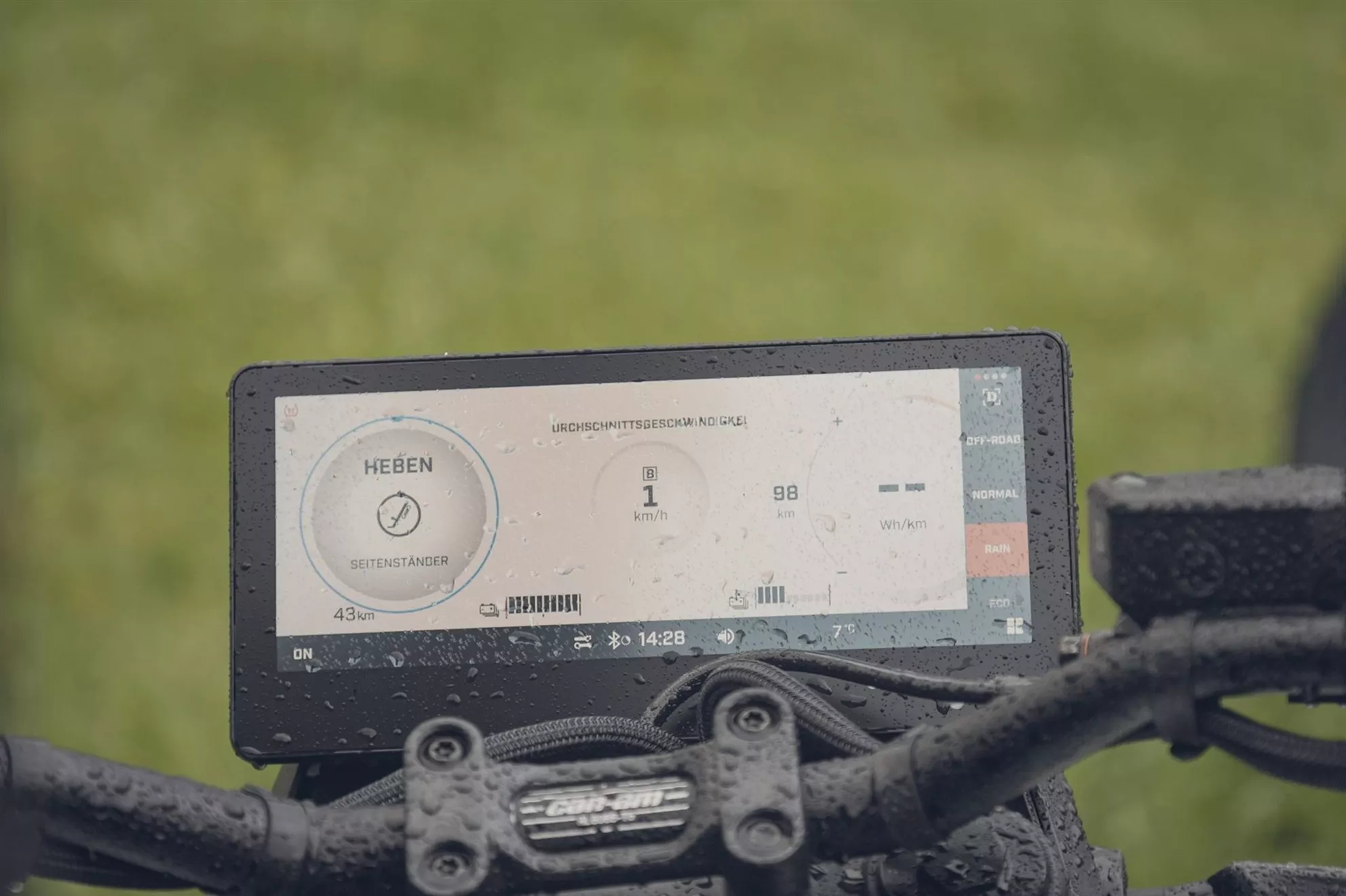
Huge and Functional - In line with the futuristic concept of the e-adventure bike, the display is also large. However, the operation could be a bit more straightforward.
Unlike many other e-off-roaders, both the motor and the battery are liquid-cooled here. This prevents heat damage to individual cells, even in high ambient temperatures or during prolonged stress in rough terrain. Overheated cells can compromise the entire battery pack—comparable to the weakest link in a chain. With liquid cooling, all cells remain within the optimal temperature range, which not only stabilizes performance but also significantly extends battery life. It's a technical detail rarely implemented in the e-sector, but it makes sense for the Can-Am Origin.

Annoying: Safety warnings must be clicked away each time you start.
Pro rider Busty quickly focused on the electronic rider aids, and it becomes clear how much is adjustable. Various ride modes, ABS, and traction control can be disabled, which is essential for sporty off-road riding. It took him a moment to find the right menu options, but he was satisfied with their effect afterward. However, what bothered him was the startup procedure itself: a cumbersome process involving safety queries, terms of service confirmations, multiple throttle movements, and start button interactions. When you just want to get going quickly, it feels overly lengthy and over-engineered.
Comfortable, Neutral, and Predictable - The Suspension & Handling of the Can-Am Origin 2025
The suspension of the Can-Am Origin immediately draws attention with its 43 mm upside-down fork. The dimensions generally seem appropriate, especially regarding the travel, which is solid. However, the suspension hardware features a non-adjustable setup, limiting customization both front and rear. So, as a rider, you get the setup that Can-Am provides as standard. For my weight of about 75 kg, the setup was generally fine. It doesn't reach top-level in terms of responsiveness and reserves, but it fits the intended use. In reality, with an e-adventure bike like this, you're likely to ride more moderately off-road. A point of concern: the rear shock is relatively exposed directly behind the rear wheel and consequently collects a lot of dirt. Although there is a plastic guard, over time, especially in wet weather like during our test days, a considerable amount can accumulate. This could potentially affect its function in the long run.
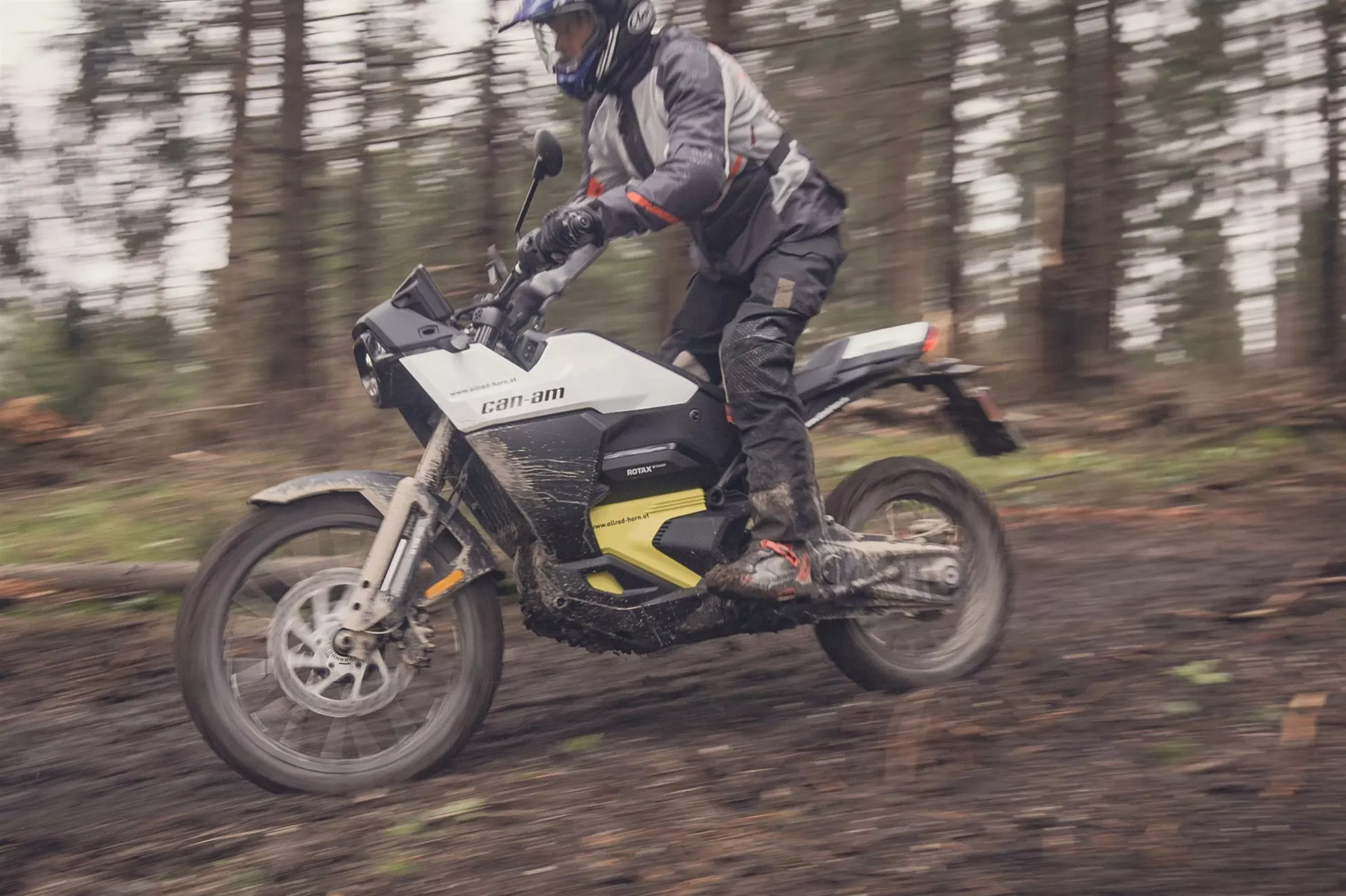
The handling of the Can-Am Origin is unique and very stable due to the special construction of the drivetrain. The suspension performs adequately but would ideally be adjustable, especially considering the considerable price of the Origin.
Nonetheless, there's an important technical trick that's unique in the e-motorcycle segment: The drive is directly flanged to the swingarm and connected as a single-sided swingarm with a closed drive system featuring an internal chain. This prevents the typical rear sag during acceleration—there's no load moment pulling the rear down. As a result, the motorcycle remains very neutral when accelerating out. Initially, this behavior is a bit unusual, as one expects different feedback with classic enduros. But the longer you ride with it, the more this stoic acceleration feels right. It feels predictable, stable, and delivers maximum traction to the ground.
Busty tested the suspension at a significantly sportier pace and also reached a balanced conclusion. For him, the setup is clearly on the comfortable side. While aggressively diving into deep holes or bumps, he did feel the end of the suspension travel, but harsh jolts to the handlebars or footpegs were absent. This shows that the tuning is not intended for hardcore off-road action but is more oriented towards touring and adventure riding. And within this scope, the suspension fulfills its purpose completely—even if ambitious riders like Busty might find its limits.
Distinctive Ergonomics - Balancing Control and Compromise
The ergonomics of the Can-Am Origin 2025 evoke mixed feelings. On the positive side, the bike's slim waist is well-designed, and it doesn't become uncomfortably wide towards the front. In slow, technical sections—like maneuvering around trees in a tight forest—you can ride very precisely and playfully. Without needing to modulate a clutch, the focus can be entirely on shifting weight and following the riding line. Guiding the knee along the tank and steering the bike with a fine front-end feel over rooted trails is where the combination of a powerful, easily controllable electric motor and compact ergonomics pays off. However, when it comes to longer rides at higher speeds—like maintaining a steady pace on gravel roads—the low handlebars and high footpegs become a disadvantage. The resulting hunched posture is uncomfortable. The taller the rider and the longer the standing ride, the worse it gets. In these moments, the ergonomics seem less well thought out.
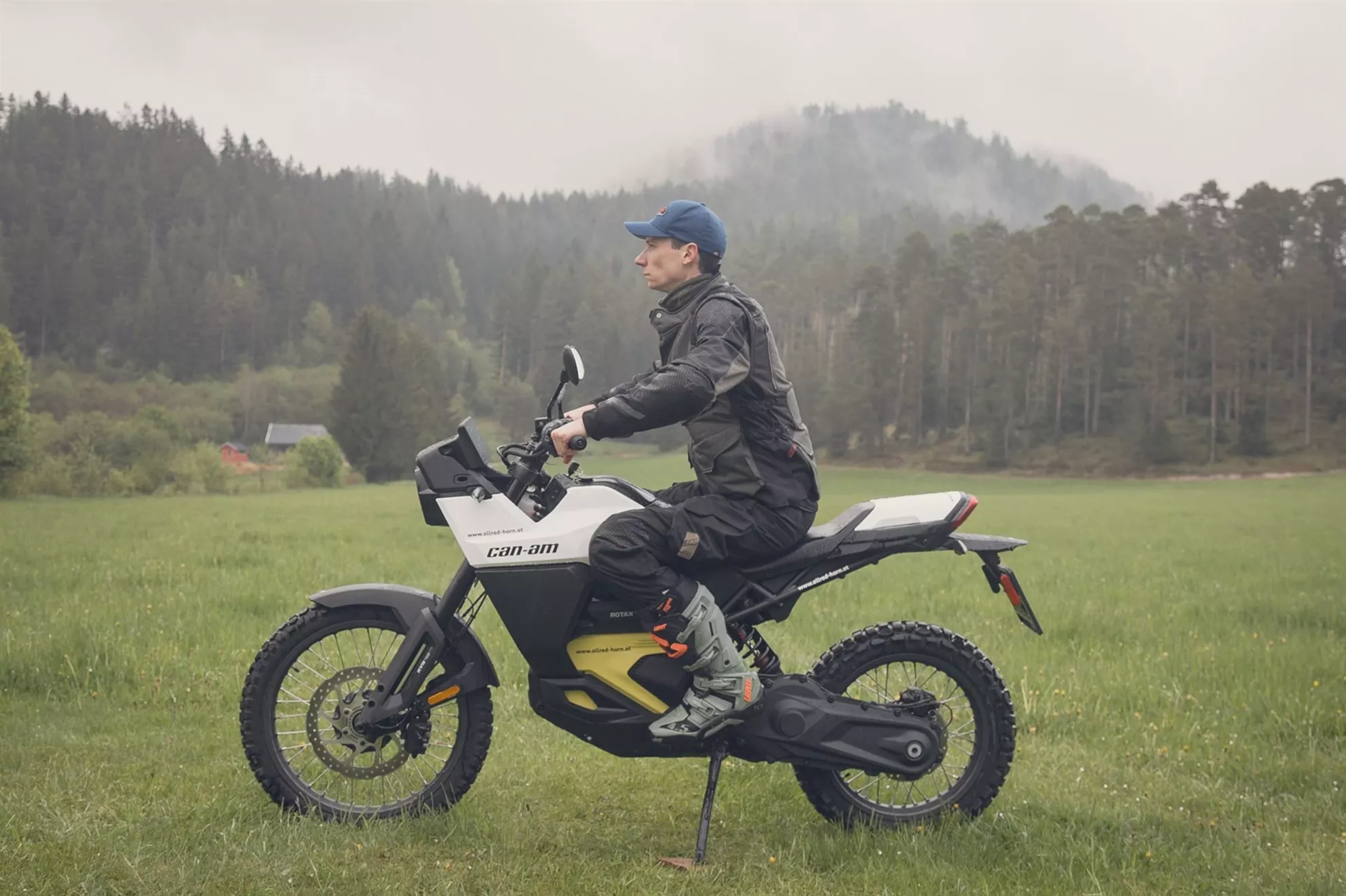
Mex, 1.92 m, seated on the Can-Am Origin
The tall Mex encountered similar limitations, particularly with the footpeg positioning. For his taste, they are mounted unusually high, which leads to a sharper knee angle when seated—atypical for an enduro. When riding standing up, he has to lean very far forward, which negatively affects his freedom of movement. He also finds the distance between the pegs and the handlebars to be too short. Mex suggests that it would be more ergonomically coherent if the handlebars were positioned three to four centimeters further forward—there's enough room for that in the cockpit. For smaller or lighter riders, the concept might work well due to the low seat height and narrow waist.
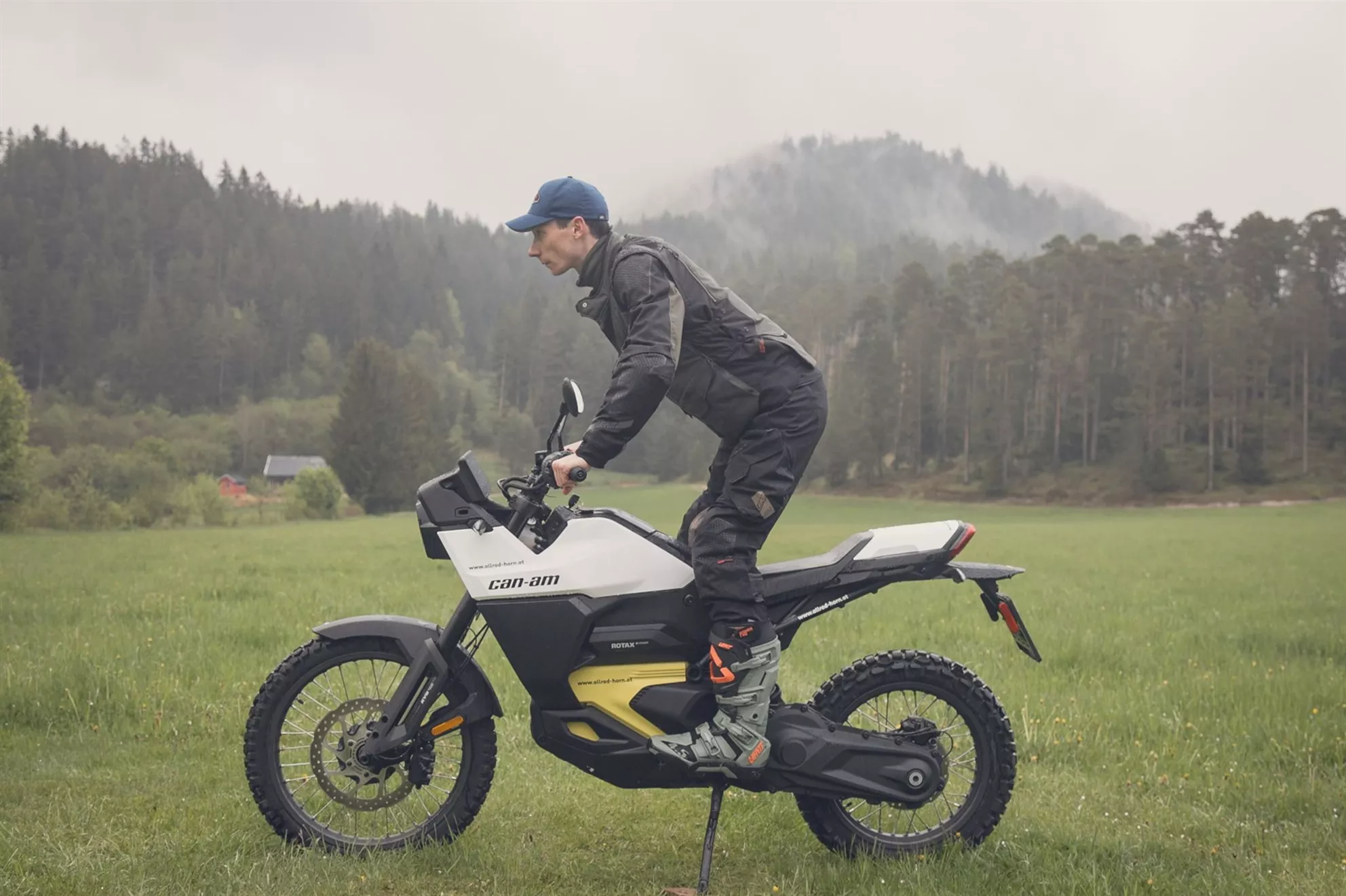
Mex, 1.92 m, standing on the Can-Am Origin
Busty also had to get accustomed to the ergonomics initially. For him, the main issue was the high position of the footpegs. This shifts the bike's overall center of gravity higher. During sporty standing rides, he has to lean more forward, which restricts his usual posture. At the same time, Busty noted that the seating position itself is comfortable. When sitting—such as in touring mode—the distance to the handlebars fits, and the height of the pegs is less noticeable. Overall, the impression is clear: while the seating ergonomics are consistent, the standing position demands some compromises, especially for tall or sporty riders.
Aggressive Rear, Weak Front – Braking Performance and Regeneration
The braking system is one of the most challenging aspects to get used to on the Can-Am Origin 2025. It starts with the front brake's pressure point, which feels very soft and spongy. Combined with the rather comfortably tuned suspension, there's a lack of precise feedback on the front wheel's grip limit. Instead of confidence, there's uncertainty—a feeling that can quickly have negative effects off-road. On the other end of the bike, the situation is the opposite: the rear brake is extremely aggressive. The transition from minimal braking effect to a locking rear wheel is too abrupt, with insufficient progression. In tight corners or during gentle deceleration, the Can-Am was the bike I had to brake most cautiously with. It does benefit from an overall low center of gravity, which helps in tight maneuvers, but the total weight is still just under 190 kilograms. You definitely feel that when things get serious in the braking zone.
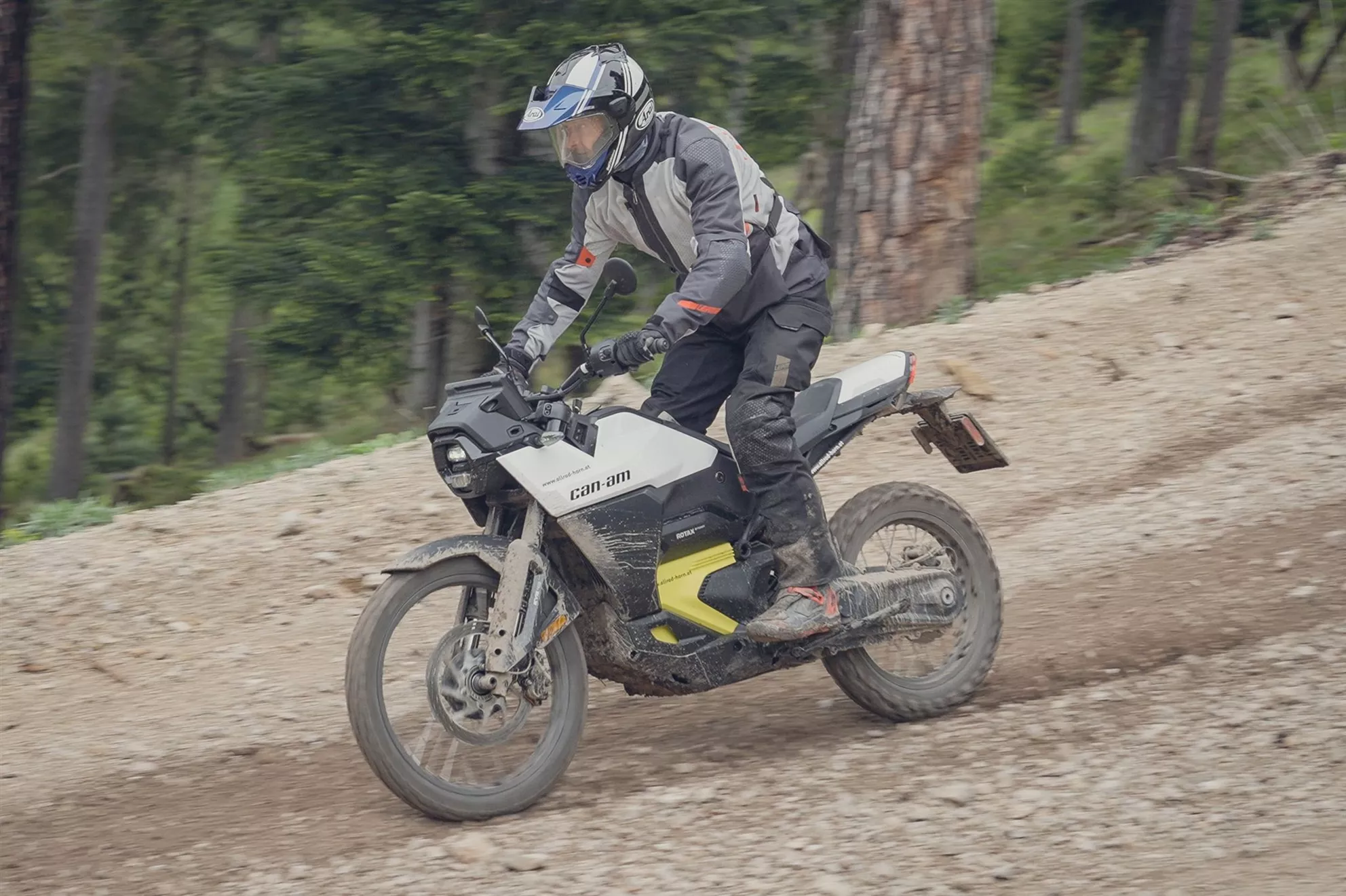
Active regeneration is a great idea, but in combination with the sharp rear brake on the Origin, it requires a lot of finesse in the braking zone.
Busty also noted several critical points about the braking system, particularly in relation to active regeneration. Another unique technical feature of the Can-Am: when you twist the throttle forward from the standard position, the motor braking effect progressively increases, and additional energy is recovered. However, during off-road riding, this can quickly lead to unwanted surprises, especially if you're unfamiliar with the system. Busty experienced such a situation when he braced himself while braking in a standing position, slightly moving the throttle forward, and the active regeneration suddenly locked the rear wheel. Combined with the already sharp rear brake, this was a critical moment. His recommendation: better to disable this feature off-road. On the road, however, he sees it as a valuable addition—especially since it can significantly extend the limited range. More information can be found in the first Can-Am Origin test.
Busty is also critical of the overall braking behavior: the balance between the front and rear brakes is uneven. The front brake feels too weak to him, while the rear brake reacts overly aggressively. Even in pure mechanical mode without regeneration, this imbalance persists. In summary, the braking system of the Can-Am Origin is currently not a highlight for sporty, ambitious off-road riders—neither in feel nor in control.
Adventure Spirit with Limitations - Long-Distance and Durability of the Origin
The Can-Am Origin 2025 introduces intriguing concepts for the adventure and travel sector, even though its range contradicts that of a true long-distance machine. Officially, it boasts a range of about 100 kilometers. In practice, especially with spirited riding or rough terrain, this often reduces to around 50 to 60 kilometers. Therefore, the term "long-distance motorcycle" should be used with caution here. Nonetheless, it's worth examining the construction details, as the Origin brings several features that are appealing to adventurers and frequent riders, regardless of battery capacity.
The machine demonstrates service-friendliness, particularly in its drive system. Although no traditional oil change is required, the central drive unit contains oil that needs to be changed for the first time after 5,000 kilometers and then only every 10,000 kilometers. The internally located chain within the enclosed drive case is continuously auto-tensioned and, according to the manufacturer, needs to be checked only every 25,000 kilometers. During the presentation, it was optimistically suggested that this chain could theoretically last a motorcycle's lifetime. Additionally, there is a bolted rear frame, well-protected linkage, and sturdy footpegs. However, the question remains how easy it is to access sensitive components in an emergency, as many parts are very integrally built.
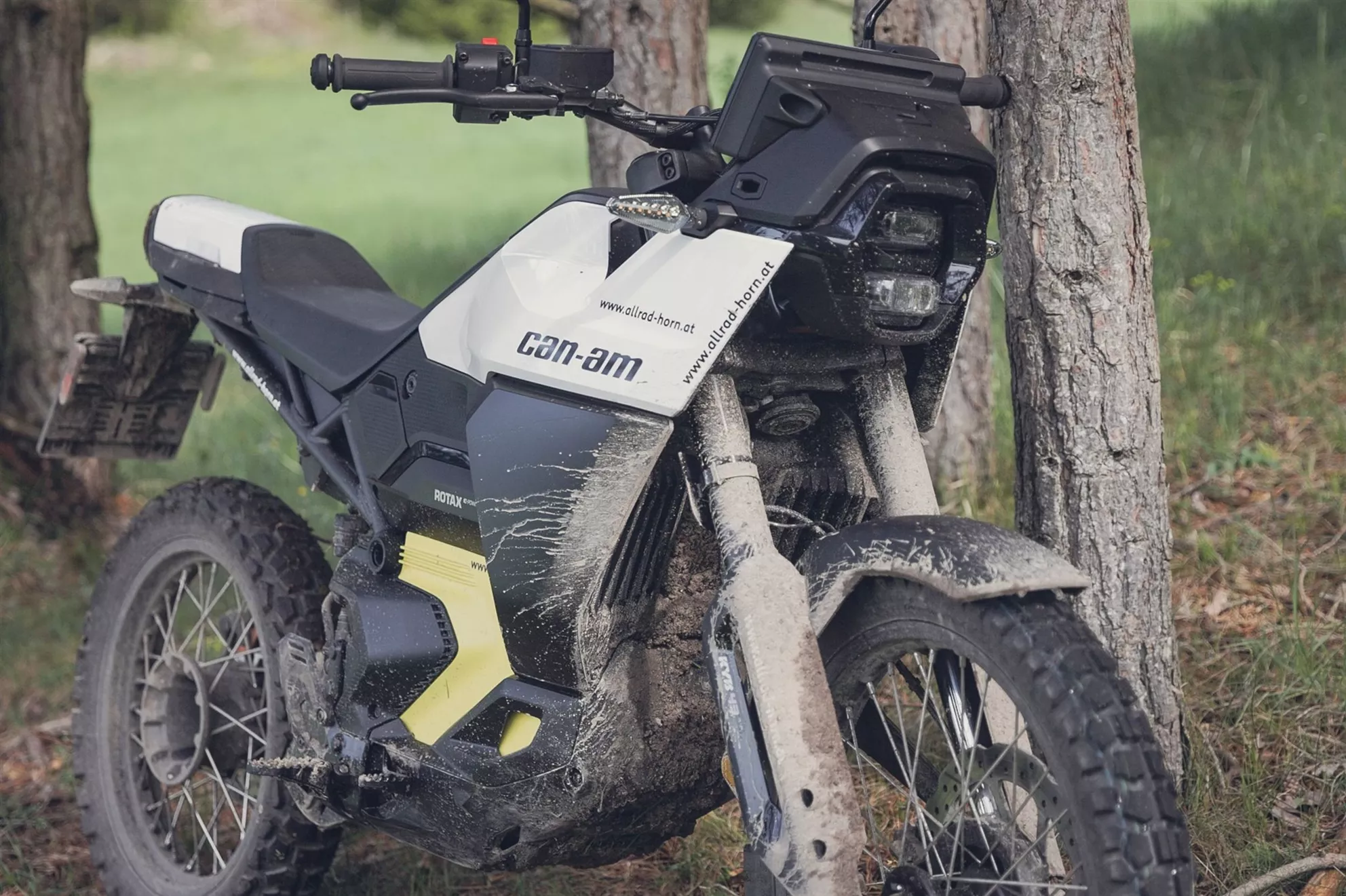
Beyond its limited range, the Can-Am Origin offers several adventure qualities.
The robustness in off-road use is also intriguing. The Origin eliminates many classic weaknesses of an internal combustion engine, such as sensitivity to water. With no intake systems or exhaust present and the motorcycle supposedly being completely waterproof, you could theoretically take it underwater. The battery block's protection also appears massive and stable, significantly more robust than, for instance, an exposed oil cooler on conventional machines. In terms of tires, the Origin is equipped with classic enduro dimensions: 90/90-21 at the front and 120/80-18 at the rear. The narrow rear tire follows motocross standards, providing a solid foundation for serious off-road tires.
Pro's Verdict: Plenty of Tech, But Who's It For?
The Can-Am Origin 2025 is undoubtedly an intriguing motorcycle—particularly because of its technical approaches that aren't found in this form on traditional combustion engines or other manufacturers. Features like active regeneration, the clever drive unit, and the liquid-cooled battery pique interest and demonstrate a spirit of innovation. But when riding, many questions remain. The range is too limited for an adventure tourer, it lacks agility for sporty off-road riding, and the ergonomics—especially with the high footpegs—don't fit the usual mold. The bike doesn't feel nimble enough or mature enough for defined purposes. The longer you ride the Origin, the more you discover things that are fun. Yet, in the end, the question remains: who is this motorcycle really made for? It's a concept with potential that still needs to find its place.
Hobby Enduro Rider's Verdict: Unique, Unconventional - Yet Fascinating
After intense days in the mud, it's clear to me: The Can-Am Origin 2025 offers an absolutely unique riding experience. From the drive unit to the geometry and handling on loose terrain—everything feels distinctive. The engine is a real joy, the digital, extremely stable riding feel is impressive, and the compact concept with a low center of gravity performs surprisingly well off-road. However, I wish Can-Am would further refine this electric adventure bike concept. I expected more quality in the suspension and braking system—especially at this price point. The MSRP is a hefty €16,499. And that's probably the main reason why the Origin will never be a mass-market product. It's a niche motorcycle for enthusiasts with a penchant for technology—and the budget for a third or fourth bike. However, anyone who gets the chance to ride it should definitely do so. Its uniqueness will certainly broaden your horizons—especially if you only have an A1 license.
Leatt ADV Suits Off-Road Test: Two Robust Solutions for Any Weather
At the 2025 Off-Road Test Days, Leatt's two adventure suits impress with functionality, protection, and comfort. The MultiTour 5.5 is a weatherproof all-rounder with a three-layer construction, a 20,000 mm waterproof inner jacket, and thoughtful ventilation—ideal for 10 to 20°C and changing conditions. The FlowTour 5.5 features large mesh panels, a sporty cut, and a waterproof outer jacket—perfect for active riders at 25°C and above. Both offer high-quality Level 2 protectors, clever details like hydration system preparation, and adjustable widths. Those seeking uncompromising touring functionality should opt for the MultiTour. Those who appreciate lightness, airiness, and flexibility will find the FlowTour just right.

From left: Chad, McGregor, Mex & Busty. The testing team at the 2025 Off-Road Test Days
More Tests from the 2025 Off-Road Test Days
- How much does a Can-Am Origin cost?
- Here you will find an overview of the price level of new and used motorbikes!
&width=60&height=60&bgcolor=rgba_39_42_44_0&mode=crop)
Can-Am Origin 2025 - Experiences and Expert Review
Gregor
The Can-Am Origin 2025 offers a unique riding experience that distinctly sets it apart from traditional enduros. With its innovative drive concept, intriguing suspension design, and digital precision, it impresses on a technical level. However, in terms of range, brake balance, and ergonomics, it becomes clear that the concept is more suited for experimental niche riders rather than the mainstream.
More from 1000PS Magazine
Can-Am Origin 2025 Off-Road Test Images
Source: 1000PS





































































